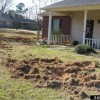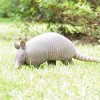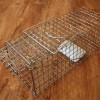 Many of us try to attract particular types of wildlife to our yards so that we can observe them. We often select plants and other materials that we know provide food, cover, and water for those animals we like to watch. However, when unwanted wildlife visit your yard and cause damage, you might need to consider the use of tactics that could deter these unwanted species. This 8-page fact sheet was written by Holly K. Ober and Arlo Kane, and published by the UF Department of Wildlife Ecology and Conservation, October 2012.
Many of us try to attract particular types of wildlife to our yards so that we can observe them. We often select plants and other materials that we know provide food, cover, and water for those animals we like to watch. However, when unwanted wildlife visit your yard and cause damage, you might need to consider the use of tactics that could deter these unwanted species. This 8-page fact sheet was written by Holly K. Ober and Arlo Kane, and published by the UF Department of Wildlife Ecology and Conservation, October 2012.
http://edis.ifas.ufl.edu/uw371
Tag: Nuisance Wildlife
How To Identify the Wildlife Species Responsible for Damage in Your Yard (WEC324/UW369)
 Although many homeowners enjoy wildlife in their yards, there are situations where wildlife can become a nuisance. In some circumstances, wild animals can cause extensive damage to lawns and gardens. Learning to identify which species is responsible for this damage is the first step in finding a solution to the problem. This 6-page fact sheet provides images of wildlife damage in residential settings to help you determine which species may be causing similar problems in your yard. Written by Holly K. Ober and Arlo Kane, and published by the UF Department of Wildlife Ecology and Conservation, October 2012.
Although many homeowners enjoy wildlife in their yards, there are situations where wildlife can become a nuisance. In some circumstances, wild animals can cause extensive damage to lawns and gardens. Learning to identify which species is responsible for this damage is the first step in finding a solution to the problem. This 6-page fact sheet provides images of wildlife damage in residential settings to help you determine which species may be causing similar problems in your yard. Written by Holly K. Ober and Arlo Kane, and published by the UF Department of Wildlife Ecology and Conservation, October 2012.
http://edis.ifas.ufl.edu/uw369
Overview of How to Stop Damage Caused by Nuisance Wildlife in Your Yard (WEC323/UW368)
 In Florida, we are fortunate to have a wide variety of wildlife to watch and enjoy. Indeed, many homeowners attempt to attract particular types of wildlife to their yards to watch. However, wild animals can become a nuisance in some situations. This 4-page fact sheet is the first in a five-part series describing tactics you can use to cope with wildlife that have become a nuisance. Here we suggest a sequence of steps you can implement when wildlife are causing damage in your yard. These suggestions should help reduce wildlife damage in a practical, humane, and environmentally responsible manner. Written by Holly K. Ober and Arlo Kane, and published by the UF Department of Wildlife Ecology and Conservation, October 2012.
In Florida, we are fortunate to have a wide variety of wildlife to watch and enjoy. Indeed, many homeowners attempt to attract particular types of wildlife to their yards to watch. However, wild animals can become a nuisance in some situations. This 4-page fact sheet is the first in a five-part series describing tactics you can use to cope with wildlife that have become a nuisance. Here we suggest a sequence of steps you can implement when wildlife are causing damage in your yard. These suggestions should help reduce wildlife damage in a practical, humane, and environmentally responsible manner. Written by Holly K. Ober and Arlo Kane, and published by the UF Department of Wildlife Ecology and Conservation, October 2012.
http://edis.ifas.ufl.edu/uw368
How to Modify Habitat to Discourage Nuisance Wildlife in Your Yard (WEC325/UW370)
 Although often overlooked, habitat modification is the cheapest and most effective long-term solution to nuisance wildlife problems in residential landscapes. Removing the resources wildlife are seeking when they visit your yard can be a much more cost-effective solution than restricting access to those resources with physical barriers, scaring wildlife with hazing tactics, deterring wildlife with repellents, or removing wildlife by trapping or killing nuisance animals. This 3-page fact sheet was written by Holly K. Ober and Arlo Kane, and published by the UF Department of Wildlife Ecology and Conservation, October 2012.
Although often overlooked, habitat modification is the cheapest and most effective long-term solution to nuisance wildlife problems in residential landscapes. Removing the resources wildlife are seeking when they visit your yard can be a much more cost-effective solution than restricting access to those resources with physical barriers, scaring wildlife with hazing tactics, deterring wildlife with repellents, or removing wildlife by trapping or killing nuisance animals. This 3-page fact sheet was written by Holly K. Ober and Arlo Kane, and published by the UF Department of Wildlife Ecology and Conservation, October 2012.
http://edis.ifas.ufl.edu/uw370
How to Use Traps to Catch Nuisance Wildlife in Your Yard (WEC327/UW372)
 When wildlife become a nuisance in your yard, there are three general approaches you can take: make habitat modifications, use deterrents, or trap animals. In most residential settings, making habitat modifications or using deterrents will be both simpler and more effective than trapping. But trapping is warranted in certain situations when trying to solve conflicts between people and wildlife. This 6-page fact sheet provides information on stopping wildlife damage through the use of trapping. Written by Holly K. Ober and Arlo Kane, and published by the UF Department of Wildlife Ecology and Conservation, October 2012.
When wildlife become a nuisance in your yard, there are three general approaches you can take: make habitat modifications, use deterrents, or trap animals. In most residential settings, making habitat modifications or using deterrents will be both simpler and more effective than trapping. But trapping is warranted in certain situations when trying to solve conflicts between people and wildlife. This 6-page fact sheet provides information on stopping wildlife damage through the use of trapping. Written by Holly K. Ober and Arlo Kane, and published by the UF Department of Wildlife Ecology and Conservation, October 2012.
http://edis.ifas.ufl.edu/uw372
WEC218/UW259: The Cuban Treefrog (Osteopilus septentrionalis) in Florida
Revised! WEC218, an 8-page fact sheet by Steve A. Johnson, describes this member of the frog family Hylidae which is invasive to Florida, how to identify it, its ecology and natural history, its impact in Florida, and what homeowners can do to manage Cuban treefrogs around their home. Includes additional resources. Published by the UF Department of Wildlife Ecology and Conservation, August 2010.
http://edis.ifas.ufl.edu/uw259